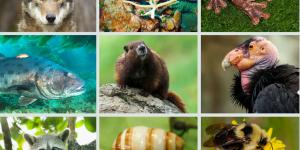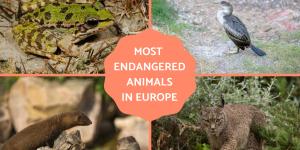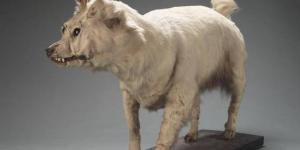Most Popular Herbivore Dinosaurs


The word dinosaur comes from the Latin dinosaurus "Terrible Lizard", an incredibly suitable name deeming the stars of the famous Jurassic Park movie. Not only were these amazing creatures at the top of the food chain for centuries, but it is also estimated that there were over 1,000 million different dinosaur species that lived on all the world's continents.
Due to the large interest and curiosity surrounding the lives of these Pre-historic lizards, we have decided to expand on their information. That is why, in this AnimalWised article, we aim to list the most popular herbivore dinosaurs that once lived on our planet.
What are herbivorous dinosaurs?
As you may already know, a herbivore is an animal or in this case, a dinosaur that is anatomically and physiologically built to only eat only plant material. It has been said that some of the biggest dinosaur herbivores had to eat at least a ton of food a day, equivalent to filling a bus with vegetation! Herbivores play an important role in the food chain, and therefore, with the impact that dinosaurs have had on the history of the world, naturally we cannot ignore the importance of herbivore dinosaurs.
6 of the most common herbivore dinosaurs include:
- The Brachiosaurus
- The Diplodocus
- The Stegosaurus
- The Triceratops
- The Protoceratop
- Patagotitan
Carry on reading to find out more about each individual dinosaur!
The Mesozoic Era
The presence of living dinosaurs lasted over 170 million years and extended over most of the Mesozoic period (more commonly known as the Secondary Age or Reptile Age). This geological era extends from 252.2 to 66 million years ago.
The Mesozoic lasted just over 186.2 million years (MA) and was composed of three periods :
- The Triassic ( between -252.17 and 201.3 AD) was a period that lasted about 50.9 million years. This is the period where dinosaurs developed. The Triassic is divided into three periods. The lower, middle and upper Triassic, which are themselves subdivided into seven stratigraphic columns. Stratigraphic columns present us with the basic units of measured time in correlation to geological timescale. Simply put, time can be told from how deep in the ground rock presents itself.
- Jurassic or¨The Age Of Reptiles¨(between 201.3 and 145.0 MA): The Jurassic period is composed of three series, the lower, middle and upper Jurassic. This time composition is immediately linked to startigraphic study of this period.
- Cretaceous (between 145.0 and 66.0 MA): The end of this period corresponds to the disappearance of both dinosaurs and ammonites. The end of this area took place due to the shock of an asteroid hitting against the earth. This meteorite crashing against the earth would have generated large clouds of dust which would have veiled the atmosphere and radically lowered the earth's temperatures until every living dinosaur was killed. This broad period is divided into two series called the Lower Cretaceous and the Upper Cretaceous. These two series are themselves divided into six floors each (twelve floors in all).
Some interesting facts about the Mesozoic (the period in which our companions lived):
- In the beginning, continents did not appear as we know them today.All land previously formed a single block called the Pangaea. This was a supercontinent that existed in the late Paleozoic and early Mesozoic periods. When the Triassic began, Pangea split into two blocks, Laurasia and Gondwana. These same two continents were further divided, Laurasia gave birth to North America and Eurasia, and the division of Gondwana allowed for the birth of South America, Africa, Australia and Antarctica. This supercontinental fracture of the Pangea was a result of the movement of tectonic plate due to intense volcanic activity.
- Climate today is no longer what it was under the primary era. The study of fossils shows that the earth's surface was divided into three distinct climatic zones. The poles were marked with white iron snow, low vegetation and mountainous landscapes. There were more temperate areas with a richer fauna.
- The Mesozoic period was marked by a severe overloading of carbon dioxide in the atmosphere. In fact, carbon dioxide in this period was five times stronger than what we have on the earth today.This large presence of carbon dioxide called on an extremely humid and warm climate. Vegetation thus became less lush and there was also a proliferation of cycads and conifers. Towards the end of the second epoch came the appearance of both monocotyledons and dicotyledonous angiosperms
- The Mesozoic era was not only characterized by dinosaurs, but also by birds and other mammals!
- Take a look at our AnimalWised article about the top 7 carnivorous dinosaurs to find out which were the strongest prehistoric creatures of the Mesozoic era!

The Brachiosaurus
Era and Etymology of the Brachiosaurus:
The name Brachiosaurus was deemed by Elmer Samuel Riggs. It originates from the ancient Greek work Brachiôn (meaning arm) and saurus (lizard), otherwise known as the "arm lizard".
This dinosaur belonged to the sarischians sauropods group, these dinosaurs roamed our land between the end of the Jurassic era until the middle of the Cretaceous period, about 161 to 145 million years ago ! The Brachiosaurus is a dinosaur star, featured in movies like Jurassic Park. The Brachiosaurus is one of the largest dinosaurs to ever live!
Brachiosaurus (appearance and diet):
The Brachiosaurus measured no less than 26 meters long, 12 meters high and its estimated weight oscillates between 32 and 50 tons! It had a very long neck, which was built of 12 vertebrae of 70 cm! This long neck has lead to heated discussions between many specialists, many argue that the Brachiosaurus would not have been able to maintain its long straight neck because, according to them, the Brachiosaurus was not strong enough to maintain such a heavy characteristic. In addition, its blood pressure had to be spectacular in order to be able to pump blood all the way to its brain. The body of a Brachiosauraus allowed it to swing its neck from right to left, bottom to top, therefore allowing it to reach extremely high heights. Brachiosaurus, as already stated, was a herbivorous dinosaur. It is assumed that this dinosaur fed on the tops of cycas, conifers and fern trees. The Brachiosaurus was a big eater. So big that it had to ingest roughly 1500kg of food per day! Brachiosaurus were thought to move in small herds, therefore allowing the adults to protect their young animals from large predators such as theropods.

Diplodocus
Diplodocus Era and Etymology :
In 1878, Othniel Charles Marsh named the Diplodocus after the presence of its double-beamed chevron bones. These small bones allowed for a formation of a long bony band in the lower part of the tail. In fact its name diplodocus is a Latin neologism derived from the Greek, "diploos" (which means double) and "dokos" (which means beam). These small bones have since been discovered in other dinosaurs.
Diplodocus (appearance and power supply):
The Diplodocus is a huge quadruped with a very long neck. This dinosaur is very easy to recognize due to its long whip-shaped tail. Its front legs were slightly shorter than its hing legs giving it a horizontal posture. When seen from afar, it resembles somewhat like a suspension bridge. Its length is estimated to measure at around 35 meters. Its head is very small in comparison to the size of its body. This head was carried by a neck of more than 6 meters long composed of at least fifteen vertebrae, we now estimate that its neck was maintained parallel to the ground because it was actually unable to hold it higher. Diplodocus weighed an estimate of between 10 and 16 tons, light compared to the heavy Brachiosaurus! Its immense tail was composed of 80 caudal vertebrae, counter-weighting its very long neck. The Diplodocus fed only on grass, small shrubs and tree leaves.

The Stegosaurus
Epoch and Etymology of the Stegosaurus :
Etymologically "Stegosaurus" means "battleship or reptile with roof", it was Othniel Charles Marsh who named it in 1877 When Marsh discovered it, he thought that the dorsal plates of the dinosaur horizontally arranged formed a kind of small roof! Marsh also named the Stegosaurus armatus which means "reptile with armoured roof"! The Stegosaurus lived about 155 million years ago on land which we know now as United States and Portugal.
The Stegosaurus (appearance and feeding):
The Stegosaurus measured up to 9 meters long at a height of 4 meters and a weighed about 3 tons! It is one of the most popular dinosaurs! It is very easily recognizable thanks to the two rows of bone plates located along its dorsal spine. Its tail presented two pairs of defensive points measuring 60 centimeters length. It is believed that these plates functioned as a kind of thermostat radiator that heated in the sun and cooled in the wind. The Stegosaurus had front legs which were smaller than its hind legs. This detail must have given it an extremely strange posture, with a head closer to the ground than the tail. The Stegosaurus had a kind of small beak that was armed with small teeth, located at the back of its mouth. This dinosaur also had cheek-pouches, which led experts to believe that it used its beak to cut grass and would thereafter store in in its cheek-pouches before chewing.

Triceratops
Epoch and Etymology of Triceratops :
The term Triceratops simply means "head with three horns", it comes from the Greek "tri" (three) "kéras" (horn) and "ops" (face). The Triceratops lived during the end of the Maastrichtian, during the Upper Cretaceous about 68 to 66 million years ago. This land is today refered to as North America. This dinosaur has been said to have been the main prey for the Tyrannosaurus Rex. Theirs are some of the most found fossils in North America.
The Triceratops (appearance and feeding) :
It is thought that the Triceratops measured between 7 to 10 meters long with a height of 3.50 to 4 meters at the withers. This specimen would have weighed between 5 to 10 tons. The most striking characteristic of the Tricératops is its broad skull. It in fact had one of the largest skulls of all terrestrial animals having ever (to our knowledge) lived on earth. The skull of the Triceratops reached almost a third of the total length of the animal! This dinosaur is also easily recognizable due to the presence of its three horns with, one was placed above the muzzle and the two others distributed above each eye. Each of these horn measured approximately 1 meter in length. Its skin is also a fascinating subject, this is because many believe that, rare for a dinosaur, its skin was covered with hair.

Protoceratops
Epoch and Etymology of the Protoceratops :
Etymologically Protoceratops means "first horned head". This first horned head walked our soil between 84 million years and 72 million years ago, on what we now know as Asia, specifically Mongolia and China. In 1971, a incredible fossil was found in Mongolia. This fossil was of a velociraptor hugging a protoceratops. According to assumptions, both would have died fighting and would have been buried by either a sandstorm or by the collapse of a dune. This is one of the oldest horned dinosaurs ever known, and is probably an ancestor to others.
In 1922, an expedition to the Gobie Desert uncovered Protoceratops nests, the first dinosaur eggs ever found! In one of the nests about thirty eggs were found, leading people to believe that this nest was shared by several females, who had to defend this nest against predators. Several other nests were found nearby, which seems to indicate that these animals lived in family groups or perhaps in small herds. Once the eggs hatched, the young, measure at less than 30 centimeters, were fed and defended by the mothers.
The Protoceratops (appearance and feeding):
Protoceratops did not have a well developed horn, it had just a small overgrown bone in its muzzle. It had a large collar-like physical head which was used to either protect its neck or to threaten away its predators. It wasn't the biggest dinosaur but it was still 2 meters long and weighed 150 kg!

Patagotitan Mayorum
Patagotitan Mayorum is a genus of sauropod Titanosauridae which was recently discovered in Argentina in 2014.
Epoch and Etymology of Patagotitan Mayorum :
Patagotitan wasrecently discovered and is one of the least known dinosaurs. Nevertheless, its full name is the Patagotian Mayorum. From an etymological point of view its name is composed of a reference to Patagonia which is the region of discovery (Pata) and a reference to Greek mythology (Titan) to evoke the power and size of this new dinosaur. Mayorum pays tribute to the Mayo family, owner of the La Flecha ranch and the lands where the discoveries were made. According to studies conducted by researchers, Patagotitan Mayorum lived between 95 and 100 million years ago in what was then a forest region.
Patagotitan Mayorum (appearance and feeding) :
Since only one fossil of Patagotitan Mayorum was discovered the figures we will mention are only estimates. Experts believe that it would have measured at approximately 37 meters and that it would have weighed at around 69 tons! Its titan name was not given in vain... Patagotitan Mayorum would be nothing more than the largest and most massive being that has ever set foot on the planet's soil. For now, it is known to be a herbivore, however, there is still a lot more research to be done.

If you want to read similar articles to Most Popular Herbivore Dinosaurs, we recommend you visit our Endangered animals category.












